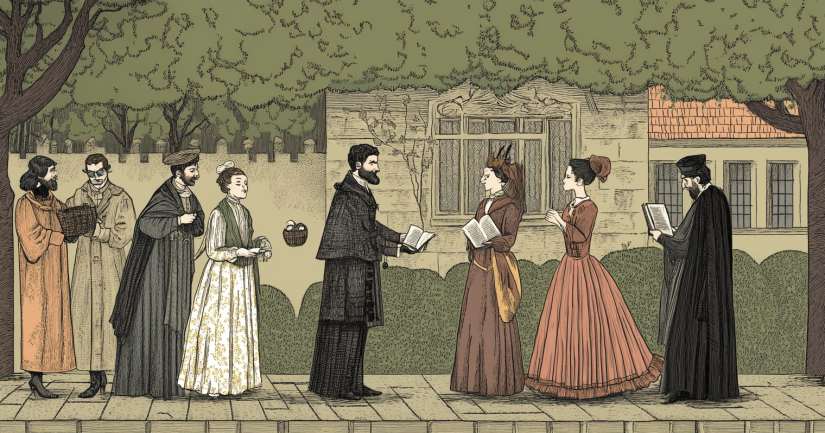The Much Ado About Nothing Order of Events Quiz offers an insightful exploration into the intricate sequence of events in William Shakespeare’s renowned play. By examining the chronological progression of the narrative, readers can gain a deeper appreciation for the thematic development and character dynamics that drive the story forward.
In “Much Ado About Nothing,” the interplay of misunderstandings, deceptions, and revelations is meticulously structured to enhance the comedic and dramatic elements of the plot. The Much Ado About Nothing Order of Events Quiz encourages readers to engage with the text in a manner that highlights the significance of each event and its impact on subsequent developments.
You’ve placed the events in order, but do you know how Shakespeare’s literary techniques shape them? Try Much Ado About Nothing Literary Devices Quiz! If you want to test your knowledge of stagecraft, check out Much Ado About Nothing Drama Terms Quiz. And when you’re ready to challenge yourself on the whole play, take on Much Ado About Nothing Full Book Quiz!
Furthermore, understanding the sequence of events allows readers to analyze the cause-and-effect relationships that underpin the characters’ actions and decisions. The Much Ado About Nothing Order of Events Quiz serves as a valuable tool for readers seeking to delve deeper into the structural intricacies of the play.
Act I: The Return to Messina
The play opens with the arrival of Don Pedro and his men, including Benedick and Claudio, in Messina. Claudio quickly falls in love with Hero, while Benedick and Beatrice resume their witty banter. Don John, Don Pedro’s illegitimate brother, begins to plot mischief.
Act II: Courtship and Deception
A masquerade ball sets the stage for romantic developments and misunderstandings. Don Pedro woos Hero on Claudio’s behalf, leading to their engagement. Simultaneously, plans are made to trick Benedick and Beatrice into falling in love with each other.
Act III: The Gulling Scenes
Through orchestrated conversations, both Benedick and Beatrice are led to believe that the other harbors secret affections. Their reactions reveal the depth of their feelings and set the stage for genuine romance. Meanwhile, Don John’s scheme to disgrace Hero unfolds.
Act IV: The Wedding Disaster
At the wedding, Claudio publicly accuses Hero of infidelity, leading to her fainting and the ceremony’s collapse. The Friar devises a plan to fake Hero’s death to uncover the truth. Benedick and Beatrice confess their love, and Beatrice implores Benedick to challenge Claudio.
Act V: Revelations and Resolutions
Borachio’s confession exposes Don John’s treachery, clearing Hero’s name. Claudio, remorseful, agrees to marry Leonato’s “niece,” who is revealed to be Hero. Benedick and Beatrice also agree to marry, bringing the play to a joyful conclusion.
Conclusion: Appreciating the Narrative Structure
The Much Ado About Nothing Order of Events Quiz facilitates a comprehensive understanding of the play’s intricate plot. By analyzing the sequence of events, readers can appreciate Shakespeare’s craftsmanship in weaving together themes of love, deception, and redemption. This exploration underscores the enduring relevance and complexity of the narrative. Much Ado About Nothing Quizzes: Love, deception, and wordplay …

Much Ado About Nothing Plot – FAQ
Much Ado About Nothing is a comedy by William Shakespeare focusing on two couples: Claudio and Hero, who plan to marry, and Beatrice and Benedick, who engage in witty banter while denying their feelings. Themes of deception, honor, and love’s complexity lead to misunderstandings and eventual reconciliations.
Deception drives the plot, used for both harm and good. Don John tricks Claudio into thinking Hero is unfaithful, causing her public shame. Meanwhile, friends of Beatrice and Benedick conspire to unite them by staging conversations hinting at their hidden affections.
The main characters are Benedick and Beatrice, known for their sharp wit; Claudio and Hero, young lovers facing obstacles; Don Pedro, a nobleman who influences the plot; and Don John, the villain aiming to disrupt others’ happiness. Each character contributes to the unfolding drama and humor.
Humor is central, adding levity and highlighting character dynamics. The witty exchanges between Beatrice and Benedick showcase Shakespeare’s clever dialogue. Dogberry, the bumbling constable, brings slapstick comedy, ensuring the play entertains while exploring deeper themes.
Conflicts resolve through revelation and forgiveness. Claudio discovers Don John’s deceit and agrees to marry who he thinks is Hero’s cousin, but is Hero herself. Beatrice and Benedick confess their love, and the play ends with a double wedding, restoring harmony.
